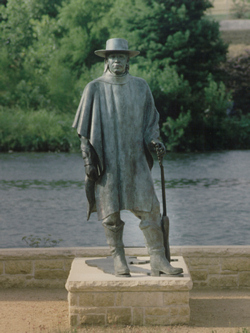| Stevie Ray Vaughan Memorial | |
|---|---|
 The sculpture in 2011 | |
 | |
| Artist | Ralph Helmick |
| Year | 1993 |
| Type | Sculpture |
| Medium | Bronze |
| Subject | Stevie Ray Vaughan |
| Dimensions | 240 cm× 110 cm× 400 cm(94 in× 43 in× 156 in); [1] |
| Location | Austin, Texas, United States |
| 30°15′47″N97°45′02″W / 30.263109°N 97.750672°W | |
Stevie Ray Vaughan Memorial is a bronze sculpture of Stevie Ray Vaughan by Ralph Helmick. The statue is an iconic landmark along the Ann and Roy Butler Hike-and-Bike Trail on Auditorium Shores of Lady Bird Lake in Austin, Texas, United States, an outdoor venue where Vaughan performed many concerts. [2]